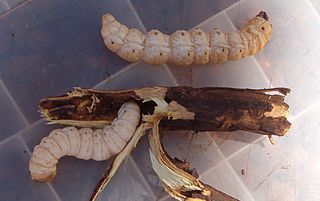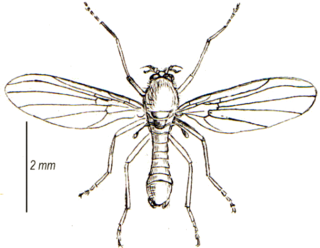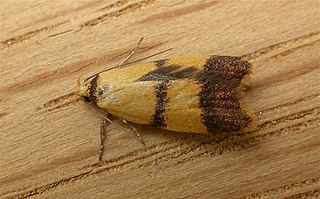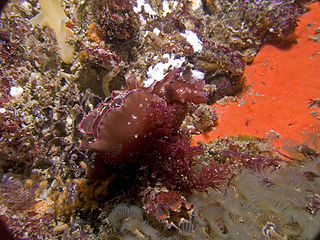
The witchetty grub is a term used in Australia for the large, white, wood-eating larvae of several moths. In particular, it applies to the larvae of the cossid moth Endoxyla leucomochla, which feeds on the roots of the witchetty bush that is widespread throughout the Northern Territory and also typically found in parts of Western Australia and South Australia, although it is also found elsewhere throughout Australia.

Thaumaleidae, the solitary midges or trickle midges, are a group of nematoceran flies related to the Ceratopogonidae, Chironomidae, and the Simuliidae. They are small, stocky, yellow to brown flies (3–4 mm). Very few species are known for this family. Larvae are found in films on rocks and the nonfeeding adults are usually found on foliage along the same streams in which the larvae are found. A few solitary midges are found in the Southern Hemisphere, but Thaumaleidae are generally an Holarctic family.

Camissonia, sometimes commonly known as sun cup or sundrop, is a genus of annual and perennial plants in the evening primrose family Onagraceae. A total of 12 species are known, nearly all from western North America, especially in the California Floristic Province, but also one from South America. Previous circumscriptions of the genus had recognized up to 62 species before it was split among other closely related genera.

The Pergidae are a moderate-sized family of sawflies occurring in the Western Hemisphere and the Australasian Region. The Pergidae are, with almost 450 described species, the third-largest family of Symphyta after the Tenthredinidae and the Argidae. Morphologically, most pergids are typically sawfly-like, but the form of the antennae varies considerably in number of segments and from simple to serrate and pectinate or even bipectinate. Sexual dimorphism is common and reflected in differences in type of antennae, colour, and size. Included are some of the few known apterous sawflies, those of the genus Cladomacra occurring in Papua New Guinea and Indonesia, and a species with brachypterous females, Clarissa tasbates, in Tasmania.

The common dwarf mongoose is a mongoose species native to Angola, northern Namibia, KwaZulu-Natal in South Africa, Zambia and East Africa. It is part of the genus Helogale, along with the Ethiopian dwarf mongoose.

Urodidae, whose species are commonly known as false burnet moths, is a family of moths in the lepidopteran order. It is the type genus in the superfamily, Urodoidea, with three genera, one of which, Wockia, occurs in Europe.

The little yellow bat is a species of vesper bat found only in Mexico.

Heteroteucha translatella is a moth of the family Oecophoridae. It is found in Australia, where it has been recorded from Queensland, the Australian Capital Territory, Victoria and Tasmania.

The dwarf sea hare or pygmy sea hare, Aplysia parvula, is a species of sea hare, a marine gastropod mollusc in the family Aplysiidae.

Protocucujidae is a family of beetles, in the superfamily Cucujoidea. It has a single known genus, Ericmodes. Species of Ericmodes are native to southern South America and Eastern Australia. Little is known of their biology, though adults and larvae probably live on vegetation, with adults having also been found in leaf litter and in flight.

Toxidia parvula, the parvula skipper or banded grass-skipper, is a butterfly of the family Hesperiidae. It is found in the Australian Capital Territory, New South Wales, Queensland and Victoria.

Grevillea parvula , commonly known as Genoa grevillea, is a species of flowering plant in the family Proteaceae and is endemic to an area near the border between New South Wales and Victoria in south-eastern continental Australia. It is a spreading to erect shrub, usually with elliptic leaves, and down-turned clusters of pinkish to red flowers.

Eucalyptus parvula, commonly known as small-leaved gum, is a species of small tree that is endemic to south-eastern New South Wales. It has mostly smooth bark, elliptical to lance-shaped adult leaves but with many juvenile of intermediate leaves in the crown, flower buds in groups of seven, white flowers and cup-shaped fruit.

Heteroteucha occidua is a moth of the family Oecophoridae. It is known in Australia from the Australian Capital Territory, New South Wales, Queensland, Tasmania and Victoria.

Holothuria parvula, the golden sea cucumber, is a species of echinoderm in the class Holothuroidea. It was first described by Emil Selenka in 1867 and has since been placed in the subgenus Platyperona, making its full scientific name Holothuria (Platyperona) parvula. It is found in shallow areas of the Caribbean Sea and Gulf of Mexico and is unusual among sea cucumbers in that it can reproduce by breaking in half.
Mount Kaye is a mountain in the Coopracambra National Park, north of the township of Cann River in East Gippsland in Victoria, Australia.

Heteroteucha is a genus of moths of the family Oecophoridae.
Nepenthes parvula is a tropical pitcher plant native to the Cape York Peninsula of Queensland, Australia.
Caleana parvula, commonly known as the Esperance duck orchid is a species of orchid endemic to a small area near Esperance in the south-west of Western Australia. It has a single smooth leaf and usually only a single greenish yellow and red flower. It is distinguished by its small flower with the calli only on the outer one-fifth of the labellum. The only other Caleana species in Western Australia which is smaller is C. lyonsii.
Polycera parvula is a species of sea slug, a nudibranch, a shell-less marine gastropod mollusc in the family Polyceridae.
















